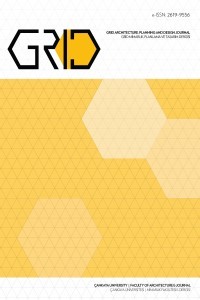Pandemi döneminde stüdyo eğitimi alan üniversite öğrencilerinin uzaktan çalışma alanlarının mekânsal dönüşümü
Uzaktan eğitim, Tasarım eğitimi, Aidiyet, Stüdyo kültürü, Aura
Spatial transformation of remote working spaces of university students receiving studio education during the pandemic
Remote learning, Design education, Belonging, Aura, Studio culture,
___
- Acar, A. (2020). Birinci sınıf mimarlık eğitimi için çevrimiçi izdüşümler. XXI. Retrieved August 28, 2022, from https://xxi.com.tr/i/birinci-sinif-mimarlik-egitimi-icin-cevrimici
- Acar, A., Soysal Acar, A. Ş. & Ünver, E. (2021). Mimarlık bölümü birinci sınıf öğrencilerinin kendi problem çözme becerilerine dair algılarının dikkat ve görsel-mekansal becerileriyle ilişkisi üzerine bir araştırma. Megaron. 16(2), 212-222. doi:10.14744/MEGARON.2021.98623
- Akış, T., Traunmüller, I. C., Kasalı, A., Tunç, A., Kul Özdemir, N., Emgin Şavk, B., Duran, H. E. & Doğan, F. (2020). İYTE Mimarlık fakültesi uzaktan eğitime geçiş anketi. Midekon. Retrieved August 28, 2022, from http://midekon.mo.org.tr/wp-content/uploads/2020/04/Uzaktan_Egitim_Anketi.pdf
- Alcocer, A. & Martella, F. (2020). Public house: the city folds into the space of the home. The Architectural Review. Retrieved March 12, 2022, from https://www.architectural-review.com/essays/public-house-the-city-folds-into-the-space-of-the-home
- Aldoy, N. & Andrew Evans, M. (2021). An investigation into a digital strategy for industrial design education. International Journal of Art and Design Education. 40(1), 283-302. doi:10.1111/jade.12334
- Auge, M. (2016). Yok-yerler: üstmodernliğin antropolojisine giriş. (T. Ilgaz, Trans.). İstanbul: Daimon.
- Aydınlı, S. & Kürtüncü, B. (2014). Paralaks oda: “öğrenmeyi öğrenme” ortamı olarak stüdyo. İstanbul: YEM Yayınları.
- Benjamin, W. (2020). Teknik olarak yeniden üretilebilirlik çağında sanat yapıtı. (G. Sarı, Trans.). İstanbul: Zeplin.
- Bhattacherjee, A. (2012). Social science research: principles, methods, and practicez. Textbooks Collection. 3. Retrieved March 12, 2022, from https://digitalcommons.usf.edu/cgi/viewcontent.cgi?article=1002&context=oa_textbooks
- Biermeier, M. A. (2015). Inspired by reggio emilia: emergent curriculum in relationship-driven learning environments. Young Children. 70(5). Retrieved August 28, 2022, from https://www.naeyc.org/resources/pubs/yc/nov2015/emergent-curriculum#:~:text=The%20third%20teacher%20is%20the,and%20environment%20that%20ignites%20learning.
- Bilen, M. (2002). Plandan uygulamaya öğretim. Ankara: Anı Yayıncılık.
- Binkley, M., Erstad, O., Herman, J., Raizen, S., Miller-Ricci, M. & Rumble (2012). Defining twenty-first century skills. Griffin, P., McGaw, B., Care, E. (Eds.). In Assessment and teaching of 21st century skills. pp. 17-66. New York: Springer.
- Büyüköztürk, Ş. (2005). Anket geliştirme. Türk Eğitim Bilimleri Dergisi. 3(2), 133-151.
- Colomer, J., Serra, T., Canabate, D. & Bubnys, R. (2020). Reflective learning in higher education: active methodologies for transformative practices. Sustainability. 12(9), 1-8. doi:10.3390/su12093827
- Çakmak, Z. (1999). Kümelenme analizinde geçerlilik problem ve kümelenme sonuçlarının değerlendirilmesi. Dumlupınar Üniversitesi Sosyal Bilimler Dergisi. 3, 187-205.
- Çakmak, Z., Uzgören, N. & Keçek, G. (2015). Kümelenme analizi teknikleri ile illerin kültürel yapılarına göre sınıflandırılması ve değişimlerinin incelenmesi. Dumlupınar Üniversitesi Sosyal Bilimler Dergisi. 12.
- Ellis-Ormand, J. (2013). Öğrenme psikolojisi. (M. Baloğlu, Trans.). Ankara: Nobel.
- Fahlen, L. E. & Brown, C. G. (1992). The use of a 3D aura metaphor for computer-based conferencing and teleworking. Proceedings of the 4th Multi-G Workshop. Stockholm, Sweden. 69-74.
- Hajirasouli, A. & Banihashemi, S. (2022). Augmented reality in architecture and construction education: state of the field and opportunities. International Journal of Educational Technology in Higher Education. 19(39), 1-28. doi:10.1186/s41239-022-00343-9
- Katz, L. G. (1987). What should young children be learning?. ERIC Digest. Retrieved August 29, 2022, from https://files.eric.ed.gov/fulltext/ED290554.pdf
- Malaguzzi, L. (1996). The hundred languages of children: the reggio emilia approach to aerly childhood education. New Jersey: Ablex Publishing Corporation.
- Miller, P. H. (2009). Theories of developmental psychology. New York: Worth Publishers.
- Norberg-Schulz, C. (1991). Genius Loci: towards a phenomenology of architecture. New York: Rizzoli.
- Öksüz, E. E. (2016). Mekanın özü: maddesel gerçeklik ötesi, mekansal aura. Unpublished M.D. Thesis. Istanbul Technical University.
- Özden, Y. (2003). Öğrenme ve öğretme. Ankara: Pegem A Yayıncılık.
- Portillo, J., Garay, U., Tejada, E. & Bilbao, N. (2020). Self-perception of the digital competence of educators during the COVID-19 pandemic: a cross-analysis of different educational stages. Sustainability. 12(23), 1-13. doi:10.3390/su122310128
- Senemoğlu, N. (2020). Gelişim, öğrenme ve öğretim: kuramdan uygulamaya. Ankara: Anı Yayıncılık.
- Tam, C. (2022). The third teacher: architecture as enabler of active learning. Unpublished M.A. Thesis. Massachusetts Institute of Technology.
- Thomas, R. M. (1998). Conducting educational research: a comparative view. Bergin & Garvey.
- Torres Martin, C. T., Acal, C., El Homrani, M. & Mingorance Estrada, A. C. (2021). Impact on the virtual learning environment due to COVID-19. Sustainability. 13(582), 1-16. doi:10.3390/su13020582
- Türkkan, S. (2020). Mimarlık eğitimini mimarlık eğitimi yapan bağzı şeyler. XXI. Retrieved August 28, 2022, from https://xxi.com.tr/i/mimarlik-egitimini-mimarlik-egitimi-yapan-bagzi-seyler
- Yurtluk, M. (2005). Proje tabanlı öğrenme. Ö. Demirel (Ed.). In Eğitimde yeni yönelimler. pp. 39-65. Ankara: Pegem A Yayıncılık.
- Yayın Aralığı: Yılda 2 Sayı
- Başlangıç: 2017
- Yayıncı: Çankaya Üniversitesi
Sıva türünün tarihi camilerin özgün akustik karakterlerinin korunmasına etkileri
Fatma YELKENCİ SERT, Özgül YILMAZ KARAMAN
Sınıf ve mekan: Endüstri kenti Karabük’te mekansal farklılaşma
15. ve 19. yüzyıllar arası tarihi kartografik malzemelerde Bodrum Halikarnas tasviri
Üçüncü biçimcilik: İstanbul'daki Arter binası üzerine bir inceleme
Umut Bora ŞAHİN, Esin KÖMEZ DAĞLIOĞLU
Merve TUNA KAYILI, Caner YETİŞ
Osmanlı sağlık yapılarında fiziksel çevre koşullarının etkileri: Edirne 2. Beyazit Külliyesi
Dinçer AYDIN, Seyhan YARDIMLI, Esma MIHLAYANLAR
Modern mimarinin sağlık ilkelerini Güzelyurt'taki örnekleri üzerinden okumak
Feriha URFALI DOĞU, Lerzan ARAS
Karantina yapılanmaları: Klazomen tahaffuzhanesi örneği
Kent deneyimi ve belleğin imgelerle dönüşümü
Fatma KOLSAL, Feran Özge GÜVEN ULUSOY
21. Yüzyılda medyanın mimarlığın kuramsal söylemindeki hareketlilikleri
